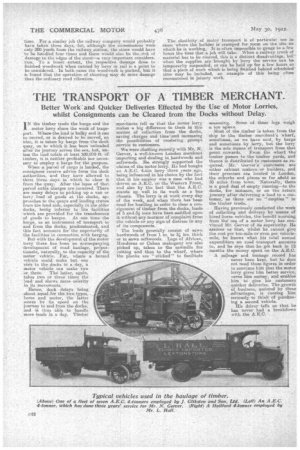THE TRANSPORT OF A TIMBER MERCHANT.
Page 36

If you've noticed an error in this article please click here to report it so we can fix it.
Better Work and Quicker Deliveries Effected by the Use of Motor Lorries, whilst Consignments can be Cleared from the Docks without Delay.
IN the timber trade the barge and the
motor lorry share the work of trans. port. Where the lead is bulky and it can be moved, or is desired to be moved, en bloc, it is taken by barge from the dock quay, on to which it has been unloaded after its journey across the sea, but, unless the load totals at least 100,000 ft. of timber, it is, neither profitable nor necessary to employ a barge for the purpose.
When a parcel of cargo is landed, the consignees receive advice from the dock authorities, and they have allowed to them three days in which to clear it. from the quay. After the lapse of that period extra charges are incurred. There are many delaysin picking up a van or lorry load of goods at the docks, approaches to the quays and loading cranes from the land side, especially in the older docks, being inferior to the facilities which are provided for the transference of goods to barges. At one time the barge, as an instrument of transport to and from the docks; predominated, and this fact accounts for the superiority of the facilities in connection with barging.
But with the development of the motor lorry there has been an accompanying development of road haulage, propertionate, naturally, to the capacity of the motor vehicle. For, where a horsed vehicle could make but One visit to the docks in a. day, a motor vehicle can snake two
• or three. The latter, again, takes two or three times the load and shows more celerity in its Movements.
Hence, dock delays being about equalfor the two, types, horse and motor, the latter scores by its speed on the journey to and from the docks, and is thus able to handle more loads in a day. Timber merchants tell us that the motor lorry makes a big difference to them in this matter of collection from the docks, saving charges and time andincreasing the possibilities of rendering prompt service to customers.
We were chatting recently with Mr. N. G-'erver, a well-known London merchant importing and dealing in hardwoods and softwoods. He strongly supported the claims of the motor lorry. He had bought an A.E.C. 4-ton lorry three years ago, being influenced in his choice by the fact that in his employ was a man who had driven an A.E.C. on the Western Front, and also by the fact that the A.E.C. standa up well in its work as a bus chassis. The lorry is at work every day of the week, and when there has been need for bustling in, order to clear a, consignment of timber from the docks, loads of 5 and.51 tons have been saddled upon it without any murmur of comPlaint from the vehicle or any sign of distress in any of its components.
The loads generally consist of sawn hardwoods of from 1 in. to 31 ins, thick or in sawn softwoods. Logs of African, Honduras or Cuban mahogany are also picked up, taken to the sawmills for cutting and then to the wharf, where the planks are " sticked " to facilitate seasoning. Some of the logs weigh a ton apiece. Most of the timber is taken from the ship to the timber merchant's wharf, sometimes, as we have said, by barge and sometimes by lorry, but the lorry is the sole means of transport from that point onwards. From the wharf the timber is to the timber yards, and thence ss distributed to customers as required. Mr. Garver's customers are either cabinet makers or builders, and their premises are located in London, the suburbs and places so far afield as 30 miles from town. Naturally, there is a good deal of empty running—to the docks, for instance, or on the return journey after delivering a load to a customer, as there are no "empties" in the timber trade.
Having previously conducted the work of collecting and delivery by means of hired horse vehicles, the benefit accruing frond the' use of a motor lorry has convinced Mr. Cerver of its superiority. He assures us that, whilst he cannot give the cost per ton-mile or even per vehiclemile, he knows what his total annual expenditure on road transport amounts to, and he says that he got heck in 12 months the money spent on the A.B.C.
A mileage and tonnage record has never been kept, but he does not need those figures in order to convince him that the motor lorry gives him better service, saves him money, and enables him to give his customers quicker deliveries. The growth of business, assisted by these advantages, is causing him seriously, to think" of purchasing a second vehicle. His driver tefls us that he has never had a breakdown with the A.E.C.












































